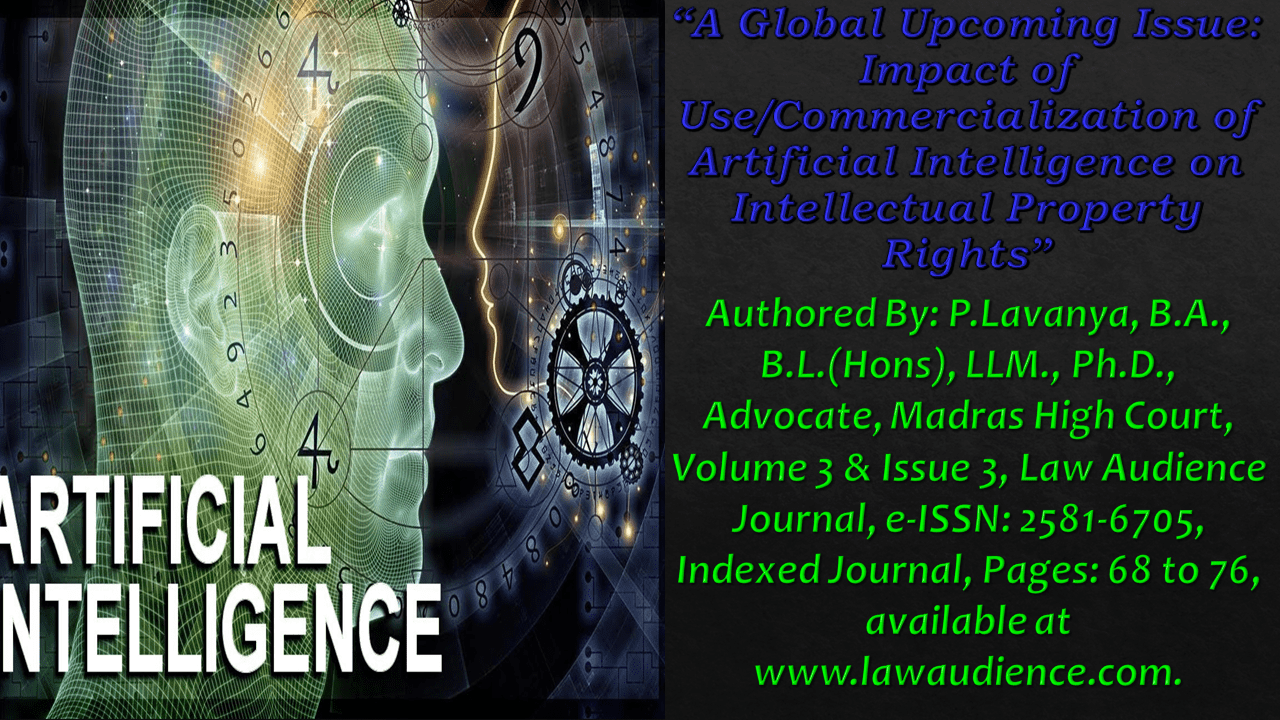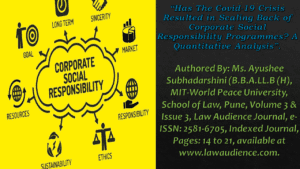Click here to download the full paper (PDF)
Authored By: P.Lavanya, B.A., B.L.(Hons), LLM., Ph.D., Advocate, Madras High Court,
Click here for Copyright Policy.
ABSTRACT:
“Artificial intelligence (AI) has evolved in the sphere of innovation and creativity and is supposed to develop into an integrated piece of daily life in the near future. New AI technologies represent thrilling opportunities for advancements in the creative arts, entertainment industries, as well as life boosting inventions. Nevertheless, of course, there are social, economic and ethical implications that need to be addressed and policy that needs to adjust accordingly. As such, we welcome the WIPO public consultation that seeks for measures to encourage technological innovation.[1]
Intellectual property has always had a symbiotic relationship with the development of new technology and in turn policy has needed to adapt to keep pace with the technology and cultural changes. AI technology has the potential to shake up the IP system, raising fundamental questions from inventorship and authorship to ownership and infringement. We believe that the advancement of AI technologies requires urgent attention from policy makers in order to ensure the effectiveness of the intellectual property regime, and to a greater extent to mitigate harmful social, economic and ethical implications”.
I. INTRODUCTION:
A few years after Alan Mathiso Turing, a prominent English mathematician, cryptologist and computer scientist played a crucial role in conquering Hitler’s Nazi Germany, he inscribed a paper titled ‘Computing Machinery and Intelligence’ (1950) where he asked a simple, yet interesting question: “Can machines think?” His paper and successive study recognized the basis of what we refer to as ‘Artificial Intelligence’ (AI) or machine learning/intelligence. Fast progress to today, the notion of AI has become a lot more complicated than what had been envisioned by researchers about half a century ago. AI or a machine which shows the capability to think and act in as close of a manner as a human mind is as of date, an exhilarating new growth in the field of technology. From ‘The Turin Test’ in the year 1950 to creation of Sophia, a humanoid robot created by Hanson Robotics in the year 2016, technology, especially in the field of AI has progressed at a drastic rate, with some of the major developments being the creation of Google’s Home device (2016), Apple’s virtual assistant ‘Siri’ (2011), Microsoft’s virtual assistant ‘Cortana’ (2014), Amazon’s home assistant ‘Alexa’ (2014), etc. occurring in the past decade (2010 to 2019) itself. It is safe to say that with this progress, it is not far-fetched to assume that we may soon see the age of commercialization of much smarter versions of currently existing machine learning devices. The technology relating to AI has seen explosive growth in recent times with the number of patent applications for technologies relating to AI exceeding 1,00,000.[2]
Today, AI can be dissected into two types of intelligence, namely:
- Weak AI: This is a more common type of AI which is used amongst major corporations like Google, Apple, Microsoft, etc. and although it is being used widely, its abilities are limited to performing tasks that it has been trained to perform. Such AI can store data and present it to the consumer upon enquiry or on need-basis. However, the algorithms do not permit this AI to think and act in a manner a human mind would and therefore, this AI does not pose a threat within the domain of IP.
- Strong AI: Unlike weak AI, this form of AI would perform more cognitive functions that imitate a human mind more closely as against weak AI. Even though weak AI is known to perform basic functions more efficiently (when compared to humans), the strong AI will not only perform those basic functions of a weak AI but also will also perform more complex tasks such as inventing or creating a new IP (like a new copyrightable sound or video or a unique design, etc.).
To a certain extent, researchers worry about the consequences of AI in case its goals end up being misaligned to ours. But at this stage, AI seems to be more promising than dangerous, especially in the field of healthcare and agriculture which is a critical industry for India. Needless to say, corporations are investing a lot of resources to develop this field of technology which is said to have revolutionary impacts including prediction of epidemics, advanced disaster warnings and damage prevention methods, increased productivity in all industries, etc.
The possibilities and benefits (and in many cases, risks) of AI are innumerable and at the current rate of its development, it will quite possibly be overwhelming. Regardless of its pros and cons, commercialization of AI is inevitable and therefore, this raises a material question: Do we have the appropriate laws in place to tackle issues arising out of commercialization (or use) of AI? The answer, unfortunately, is no.
II. THE CURRENT SCENARIO:
Being an upcoming digital frontier, it is apparent that AI will have a huge impact on our current laws and practices. For instance, our current world IP regime only permits a ‘person’ to be a proprietor and/or owner of an IP (see Naruto vs. Slater[3]) which implies that any form of IP that is generated/invented by an AI cannot be a subject matter of registration. However, a recent decision by the Chinese Court wherein a tech giant ‘Tencent’ claimed copyright infringement against a local financial news company overwork created by its Dream writer robot might reflect a contrary view. The Court in the said case held that an article generated by AI is protectable under Chinese copyright law.[4]
Holding a contrary view, the European Patent Office (EPO) in the case pertaining to patent applications filed by ‘DABUS’ an AI technology, gave a finding similar to the Naruto case wherein it held that application has to be filed by a human being.[5] Professor Ryan Abbott along-with his multi-disciplinary team at the University of Surrey had filed (through their AI called DABUS) the first-ever patent application without a human inventor[6] indicating that the move towards AI-based IP filing is underway, however, given that the laws are currently not in place, the application was, unfortunately, refused.
Although an old principle, the Courts around the world at times rely (either directly or indirectly) on the principle of “sweat of the brow”, which indicates the inventor’s effort and hard work invested in creating an IP. However, the application of the said principle becomes rather complicated when the issue of IP generated by AI comes into the picture. At the same time, the commercialization of AI might also lead to dilution of IP rights, given that the possibility of AI being better and quicker at generating IP than human beings cannot be ruled out. Undoubtedly, AI might eventually be considered as a ‘smarter’ variant of a human inventor since an AI would require a significantly less amount of time and effort to generate a registrable IP. Apart from the ones already mentioned above, several unknown issues are likely to arise upon commercialization of AI (to generate IP) and there is a dire need to highlight and resolve these issues at the earliest.
The World Intellectual Property Organization (WIPO) has recently taken an initiative to invite public feedback on possible impacts of AI on the world IP regime[7] by conducting press conferences to tackle the impending issues vis-à-vis IP laws upon commercialization or use of AI. Although the topic of discussion during the previous conference was somewhat restricted to Patent laws and did not tackle IP laws holistically, the next round of sessions might emphasize on all IP laws and be more holistic towards progress. Needless to say, AI will impact our IP regime all the way from the creation of an IP to valuation, commercialization, transfer/assignment, etc. thereof, which would require a complete overhaul of our current laws in order to inculcate and appreciate the investment (in terms of time and costs) and labour involved in the creation of the AI, as well as use/transfer/assignment of an IP generated by that AI.
II.I INDIA’S APPROACH TOWARDS ARTIFICIAL INTELLIGENCE:
India has seen rapid growth in its information technology (IT) sector which has further contributed to other primary sectors like agricultural sector, healthcare sector, etc. by developing various mechanisms such as a system for online trading or integrated crop management system (amongst other things). It is safe to say that technology has a big role to play in India’s growth. Apart from the agricultural industry, the software industry has played a pivotal role in India’s move towards becoming the fastest-growing trillion-dollar economy.[8]
Being amongst the most profitable investment jurisdictions, India has recently been a hub for tech-related start-ups. Understanding the importance of technology, Indian entrepreneurs, along-with government support, have started to invest heavily in the technology field and with the help of FDI, there has been a substantial boom in the field of technology. Since other fields such as agriculture, healthcare and education are all somewhat dependent on this field, the scope of AI transforming all the other sectors through the tech sector is clearly perceivable.
As discussed earlier, India’s healthcare sector is in a dire need for investment and development and on account of lack of funding and need to make medication accessible, reliance on AI would drastically reduce costs incurred in labour, research and development, trials, etc., which would eventually reduce the costs of pharmaceutical drugs themselves, thereby impacting the final sale price of the drug. Reliance on AI (by developing the tech sector) would extinguish the need for State governments to invest heavily in their healthcare programmes. Although the current investment might not cut it, a substantial investment, in that case, would not be required. AI support in the development and marketing of pharmaceutical drugs, thereby reducing the overall costs and increasing production and sale would also invite more FDI in India’s healthcare sector. This will also eventually make healthcare more accessible in less developed regions in India. Statistics indicate that healthcare is majorly accessible/available in limited States/Cities like Bengaluru, Chennai, Gurugram, etc.[9] while cities like Singrauli continue to suffer.[10] With the major impediment of drug pricing out of the way, access to healthcare will become more of a focus and would eventually thrive with AI support.
Insofar as the agricultural sector is concerned, the same plays an essential role in our developing economy. According to a report issued by India Brand Equity Foundation (IBEF), around 58% of Indian population relies on India’s agricultural sector with a contribution of an estimated $265.51 billion (approximately INR 18.55 lakh crore) of gross value added to its economy (in Financial Year 2019).[11] This implies that majority of the lesser developed States and Cities in India rely solely on production and sale of their agricultural produce.[12] With an FDI inflow of up to 100% and an increasing reliance on technology, the sector keeps looking for methods to increase crop yields in a cost-effective manner.
Having said that, the agricultural sector still faces some major issues like weather instability and fluctuations, condition of agricultural labourers, poor farming techniques, inadequate irrigation facilities, etc.[13] Unlike the healthcare sector, the agricultural sector is already witnessing the impact of AI from companies like Microsoft India and Intello Labs which have introduced mechanisms to maximize crop yield and reduce wastage/infestation. For instance, Microsoft India has introduced an AI-based sowing app which determines and informs the farmers of the best time to sow their crop based on analysis of climate data for the specific area and amount of rainfall and soil moisture the crops have received.[14] Farmers can benefit from these AI-based apps without spending any additional costs on installing sensors. Indian (and foreign) tech industries have already played an important role in providing ease of business through reliance on weak AI and therefore, if India invests and conducts thorough research into strong AI, the implications of AI can be countless.
However, since research and investment in the field of strong AI are extremely limited in India, commercialization thereof seems far-fetched as of date. Due to lack of expertise in the field of AI, it has been difficult to conduct research and yield any result. Colleges/Universities often refrain from investing in the field of AI research due to lack of participation and heavy research costs. Also, since the education system in the majority of institutions is somewhat traditional, graduates (or post-graduates) lack the required skill set to work in this technical field.[15]
In contrast, however, the Chinese government is already taking steps to become a leader in the AI space by 2030s. It has adopted a three-step method which involves appreciating AI-based applications by the year 2020, making cutting edge breakthroughs in the said field by 2025 and leading in the industry by 2030. To support this process, a Chinese Court has already ruled in favour of AI-generated copyright work in its decision favouring Tencent,[16] a tech company focusing on communication and social platforms. Since India (through its tech industry) has started taking steps to work towards its AI technology (albeit weak AI for now) and has also entrusted its think-tank ‘NITI (National Institution for Transforming India) Aayog’ for assistance in such development through the National Program on AI,[17] we hope to see India catch-up to tech giants like China, USA and Europe.
II.II DEVELOPMENT OF INTELLECTUAL PROPERTY LAWS ON ARTIFICIAL INTELLIGENCE: AN INDIAN PERSPECTIVE:
Since WIPO has only recently started discussing the implications of AI on global IP laws, the member states of WIPO are yet to come out with laws pertaining to AI-based IP. While beginning its public consultation process on AI and IP policy, Director General of WIPO Mr. Francis Gurry said: “Artificial intelligence is set to radically alter the way in which we work and live, with great potential to help us solve common global challenges, but it is also prompting policy questions and challenges,”.[18] On December 13, 2019 WIPO also published ‘Draft Issues Paper on Intellectual Property Policy and Artificial Intelligence’ with an intent to invite feedback/opinion on the most pressing issues IP policymakers will face in the near future.
One of the most crucial questions where jurisdictions conflict is whether AI can be an inventor/owner of an IP. While the EPO held that an AI cannot be the inventor of a patent application, the Chinese Court observed the contrary, holding that an AI can be an inventor of a copyrightable subject matter. Apart from the issues arising vis-à-vis prosecution of such applications (assuming an AI can be an inventor/originator of an IP), another important issue would pertain to enforcement by or against IP owned by an AI.
For instance, if an AI generates a copyrightable subject matter which is deceptively similar or identical to a copyrighted matter, against whom will a Suit claiming infringement and damages lie? Further, in case of a finding against the AI wherein damages have been awarded, will the AI be expected to bear the damages or the owner of the AI? To answer these complex questions, WIPO has invited inputs from member States on issues (not exhaustive) published on December 13, 2019.[19]
III. CONCLUSION:
In view afore-mentioned development, India should establish a team of technical and legal (IP) experts to review the current laws and issues drafted by the WIPO Secretariat, draft possible answers to the issues and suggest required amendments to our current laws to inculcate rights of AI in the best way possible and then discuss the same at a larger stage, i.e., at the 25th Session of the WIPO Committee on Development and Intellectual Property (CDIP). Until now, India’s role/participation in WIPO’s sessions/meetings has been passive and considering how AI would impact its various sectors, especially the agricultural and healthcare sector (a sector which needs an improvement), India must play an active role in the development of IP laws to support AI.
Given the fact that India is one of the fastest-growing economies and one of its cities is also considered as the ‘Silicon Valley’ of India,[20] commercialization/use of AI would greatly benefit its economy to the extent that it would substantially reduce labour costs and at the same time, benefit a lot of entrepreneurs in the tech industry. Additionally, AI would also be crucial for government offices as it would greatly reduce delay in processing time and errors. For instance, the use of AI in Indian Intellectual Property Offices would enable machines to review applications for basic defects such as non-filing of an essential document or improper authentication, etc. In case strong AI is adopted by these departments, it would also enable machines to raise basic objections on applications and upon clearance thereof, advertise or register the same, thereby reducing significant costs and time.
Hence, AI is going to be the next big thing in the field of technology and once it is commercialized at a large scale, it is going to have a huge impact on our laws (especially IP laws). Given India’s interests and possible benefits in the field of AI, its involvement in the development of our current IP regime is pivotal.
Cite this article as:
P.Lavanya, A Global Upcoming Issue: Impact of Use/Commercialization of Artificial Intelligence on Intellectual Property Rights, Vol.3 & Issue 3, Law Audience Journal (e-ISSN: 2581-6705), Pages 68 to 76 (15th January 2022), available at https://www.lawaudience.com/a-global-upcoming-issue-impact-of-use-commercialization-of-artificial-intelligence-on-intellectual-property-rights.
Footnotes & References:
[1] ‘WIPO Begins Public Consultation Process on Artificial Intelligence and Intellectual Property Policy’, PR/2019/843 (13 December 2019)
[2] Ryan N. Phelan, Artificial Intelligence & the Intellectual Property Landscape, Marshall Gerstein & Borun LLP, published by Lexology; link: https://www.lexology.com/library/detail.aspx?g=8c2b5986-95bb-4e8e-9057-e4481bfaa471 (published on September 14, 2019).
[3] No. 16-15469 (9th Cir. 2018).
[4] Stefano Zaccaria, AI-written articles are copyright-protected, rules Chinese court, World Intellectual Property Review (WIPR); published on January 10, 2020 (link:https://www.worldipreview.com/news/ai-written-articles-are-copyright-protected-rules-chinese-court-19102).
[5] EPO refuses DABUS patent applications designating a machine inventor, European Patent Office; link: https://www.epo.org/news-issues/news/2019/20191220.html(published on December 20, 2019).
[6] Laura Butler, World first patent applications filed for inventions generated solely by artificial intelligence, University of Surrey; published on 01 August, 2019 (link: https://www.surrey.ac.uk/news/world-first-patent-applications-filed-inventions-generated-solely-artificial-intelligence).
[7] WIPO Begins Public Consultation Process on Artificial Intelligence and Intellectual Property Policy, published by World Intellectual Property Organization (WIPO); PR/2019/843; published on December 13, 2019 (link: https://www.wipo.int/pressroom/en/articles/2019/article_0017.html).
[8] Caleb Silver, The Top 20 Economies in the World, Investopedia; link: https://www.investopedia.com/insights/worlds-top-economies/#5-india (published on November 19, 2019).
[9] Akriti Bajaj, Working towards building a healthier India, Invest India; link: https://www.investindia.gov.in/sector/healthcare (published on January 18, 2020).
[10] Leroy Leo, Niti Aayog calls healthcare system a ‘sinking ship,’ urges private participation in Ayushman Bharat, Live Mint; link: https://www.livemint.com/news/india/niti-aayog-calls-healthcare-system-a-sinking-ship-urges-private-participation-in-ayushman-bharat-11574948865389.html (published on November 29, 2019).
[11] Agriculture in India: Information About Indian Agriculture & Its Importance, Indian Brand Equity Foundation (IBEF); link: https://www.ibef.org/industry/agriculture-india.aspx (published on November 2019).
[12] Ayushman Baruah, Artificial Intelligence in Indian Agriculture – An Industry and Startup Overview, Emerj; link: https://emerj.com/ai-sector-overviews/artificial-intelligence-in-indian-agriculture-an-industry-and-startup-overview (published on November 22, 2019).
[13] Vidya Sethy, Top 13 Problems Faced by Indian Agriculture, Your Article Library; link: http://www.yourarticlelibrary.com/agriculture/top-13-problems-faced-by-indian-agriculture/62852.
[14] Ibid.
[15] Neha Dewan, In the race for AI supremacy, has India missed the bus?, The Economic Times; link: https://economictimes.indiatimes.com/small-biz/startups/features/in-the-race-for-ai-supremacy-has-india-missed-the-bus/articleshow/69836362.cms (published on June 19, 2019).
[16] Rory O’Neill and Stefano Zaccaria, “AI-written articles are copyright-protected, rules Chinese court”, World Intellectual Property Review (WIPR); link: https://www.worldipreview.com/news/ai-written-articles-are-copyright-protected-rules-chinese-court-19102 (published on January 10, 2020).
[17] National Strategy On Artificial Intelligence, published by NITI Aayog; link: https://niti.gov.in/national-strategy-artificial-intelligence.
[18] WIPO Begins Public Consultation Process on Artificial Intelligence and Intellectual Property Policy, PR/2019/843, World Intellectual Property Organization (WIPO), Geneva; link: https://www.wipo.int/pressroom/en/articles/2019/article_0017.html (published on December 13, 2019).
[19] WIPO Secretariat, WIPO Conversation on Intellectual Property (IP) and Artificial Intelligence (AI), Second Session, WIPO/IP/AI/2/GE/20/1, World Intellectual Property Organization (WIPO); link: https://www.wipo.int/edocs/mdocs/mdocs/en/wipo_ip_ai_ge_20/wipo_ip_ai_2_ge_20_1.pdf (published on December 13, 2019).
[20] Bangalore, published by Wikipedia; link: https://en.wikipedia.org/wiki/Bangalore (last updated on February 07, 0220).



